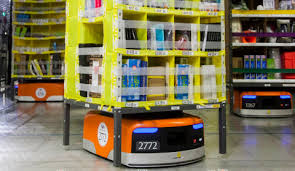Amazon Enlists Researchers to Build Box-Packing Robots
 Joshua Brustein for Bloomberg: ¬ Sixteen teams¬ of¬ robotics researchers¬ are traveling to Japan this week¬ to help Amazon.com Inc. solve its warehouse problem. The company has a¬ fleet of robots that drive around its facilities¬ gathering items for orders. But it needs humans for the last step¬ ‚ÄĒ picking up items of various shapes, then packing the right ones into the correct boxes for shipping. Its a classic example of an activity thats simple, almost mindless, for¬ humans, but still unattainable¬ for robots. Starting Thursday, the company is running the¬ Amazon Robotics Challenge, the third annual¬ contest for robots that push those limits.¬
Joshua Brustein for Bloomberg: ¬ Sixteen teams¬ of¬ robotics researchers¬ are traveling to Japan this week¬ to help Amazon.com Inc. solve its warehouse problem. The company has a¬ fleet of robots that drive around its facilities¬ gathering items for orders. But it needs humans for the last step¬ ‚ÄĒ picking up items of various shapes, then packing the right ones into the correct boxes for shipping. Its a classic example of an activity thats simple, almost mindless, for¬ humans, but still unattainable¬ for robots. Starting Thursday, the company is running the¬ Amazon Robotics Challenge, the third annual¬ contest for robots that push those limits.¬
Both academic and commercial¬ roboticists have been putting a lot of energy into¬ solving¬ whats sometimes referred to as the¬ ‚Äúpicking‚ÄĚ challenge, and Amazon is trying to direct that energy towards its specific needs. In one part of the contest, teams fill a¬ shelf¬ with a¬ random assortment of items¬ that Amazon provides¬ ‚ÄĒ¬ a champagne glass, a roll of duct tape, scissors, a childrens book entitled¬ ‚ÄúRobots, Robots Everywhere‚Ä̬ ‚ÄĒ and their robots pull out specific items, packing them into boxes that represent pretend Amazon orders. In¬ another, robots confront a jumble of items, and pack them onto shelves that resemble those in Amazon warehouses, remembering where each one went. Theres about $250,000 of prize money at stake, including $80,000 for the top prize.¬
¬
Amazon gets nothing out of this, directly. But their own robotics team can potentially pick up techniques, or even new colleagues -- it has hired people who have entered past contests. More broadly, having robots that could reliably carry out the tasks from the challenge¬ on their own would be a big step¬ towards¬ fully autonomous warehouses, which theoretically could run faster,¬ cheaper, and around the clock.
¬
This raises uncomfortable questions about¬ the future prospects for warehouse workers. In May, there¬ were¬ 949,000 people working in¬ the¬ warehouse¬ and storage¬ industry in the U.S., making an average wage of just under $20 an hour,¬ according to the Bureau of Labor Statistics. The number of people working in the warehouse industry has grown 43 percent over¬ the¬ last decade, and wages have kept pace with inflation, even as a first wave of automation has taken place. Optimists argue that more automation leads to more growth, creating better jobs elsewhere. Pessimists are basically predicting that artificial intelligence will usher in an economic apocalypse. ¬ Full Article:
¬
Comments (0)
This post does not have any comments. Be the first to leave a comment below.
Featured Product

